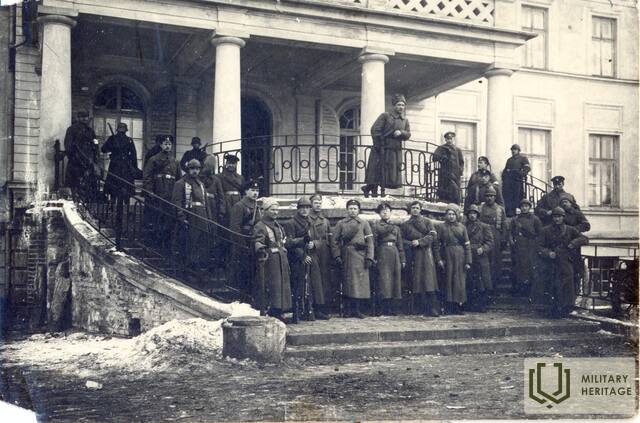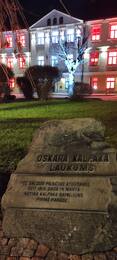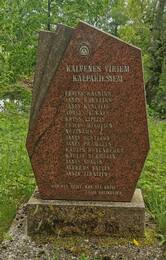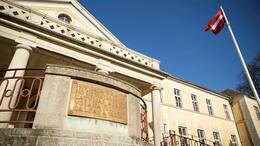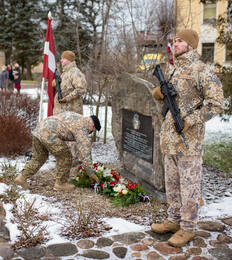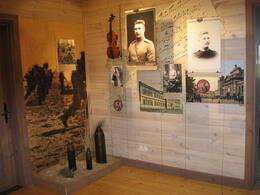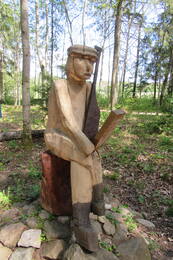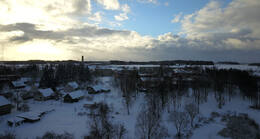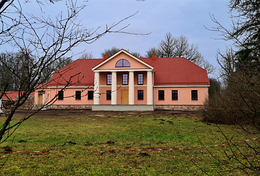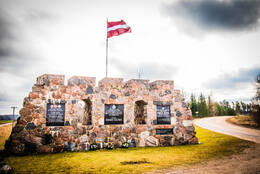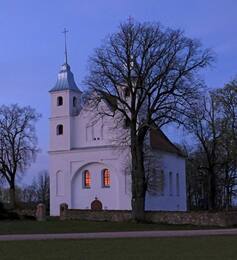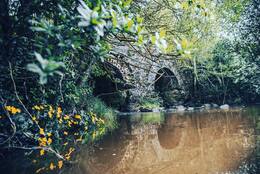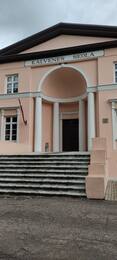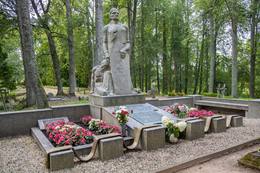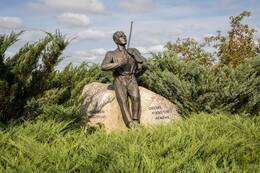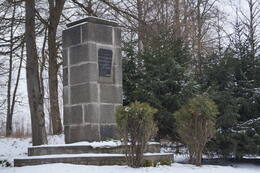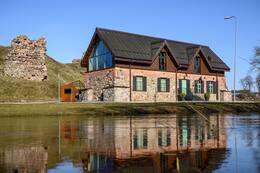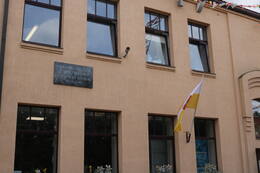Läti iseseisev pataljon
I Vabadussõjad, I I maailmasõda, Balti riikide iseseisvus
Läti iseseisev pataljon, tuntud ka kui Kalpaki pataljon (5. jaanuar 1919 - 20. märts 1919), oli esimene Läti relvastatud üksus vabadusvõitluse ajal, mis kuulus Läti Rahvuskaardi ehk Balti maaväe koosseisu.
21. märtsil 1919 andis Läti Ajutine Valitsus käsu muuta Läti Sõltumatu Pataljon Läti Sõjaväegrupiks Lõuna ehk Lõuna-Läti Brigaadiks.
Seotud ajajoon
Seotud objektid
Mälestuskivi Oskaras Kalpaka platsil Salduses
O.Kalpaka väljak asub Salduse kesklinnas, Lielā ja Striķu tänavate ristumiskohas.
Endine turuplats on tänapäeval Salduse elanike ja külastajate lemmikpaik, kus toimuvad kontserdid, mälestusüritused ja pidustused. 10. märtsil 1919 sai Saldus esimeseks Läti linnaks, mille vabastas kolonel Oskars Kalpaksi pataljon.
14. märtsil 1919 toimus platsil Läti Separatiivpataljoni esimene paraad. 1992. aastal nimetati plats kolonel Kalpaksi auks tema järgi.
Monument ja mälestusmärgid O. Kalpaka pataljoni sõduritele Aizpore kalmistul
Umbes poolel teel Rudbārži ja Kalvė vahel, A9 maanteega paralleelselt kulgeva vana tee ääres, asub Aizpore kalmistu.
Seal on monument ja 12 mälestusmärki Oskars Kalpaka pataljoni vabatahtlikele sõduritele, kes elasid ümbritsevates majades.
Kalvene valla Aizpore poolmõis oli kõige kaugem koht, kuhu Läti Erakondlik (Kalpaka) pataljon 22. jaanuaril 1919. aastal taganes. Siin sai pataljon Liepājast oma esimese tugevduse - 35 meest - ja alustas vastupealetungi, jõudes 24. jaanuaril Rudbārži.
Mälestusmärgi püstitamise idee tekkis 1920. aastatel, kui 1. Läti Separatiivpataljoni ehk Kalpaka pataljoni endised sõdurid püstitasid ajutise mälestustahvli - tammeploki koos mälestustahvliga. Toona sündis mõte luua suurem mälestusmärkide ansambel, kuid see sai teoks alles 15. mail 1993, kui avati mälestusmärk - Valguskiir -, mis on hallist graniidist obelisk.
2,3 m kõrgune mälestusmärk on valmistatud skulptorite Harijs SPRINCIS ja Imants LUKAŽIS (1930 - 2007, maetud Aizpuri kalmistule) poolt, kelle isa oli samuti O. Kalpaka pataljoni sõdur. Mälestustahvlile on graveeritud luuletaja E.VIRZA nimed:
KALPAKAM
AND HIS
SÕDURITELE
1919
25. JAANUARI HOMMIKUL
SIIT PÄEVASTI
KA ALATES
TULI
ÜLE LATVIA
Samal ajal tähistati kalmistule maetud 12 Kalpaku hauad tammepuust mälestustahvlitega, mis 2019. aastal asendati graniidist mälestustahvlitega.
1990. aastate alguses püstitati kalmistule kahe meetri kõrgune mälestusmärk, mille kõrval kasvab tamm, mille istutas 1990. aastate keskel legendaarne näitleja Ēvalds Valters.
Rudbārži mõisa loss ja mälestustahvel 1. Läti Separatiivpataljonile
Loss asub Rudbāržis, Riia-Liepāja maantee A9 ääres. Hoone ees on Oskars Kalpaka pataljoni tegude mälestuseks mälestustahvel.
Loss ehitati 1835. aastal parun von Firksi perekonna valdusena paruness Thea von Firksi käsul. 15. detsembril 1905 põletasid revolutsionäärid mõisa maha. Kolm aastat hiljem algasid restaureerimistööd arhitekt L. Reiniersi juhtimisel.
Läti Vabadussõja ajal oli Rudbārži loss baasiks ja peakorteriks lahinguoperatsioonidel Venta jõe kaldal, mida juhtis kolonel Oskars Kalpaksi 1. eraldi Läti pataljon.
Hiljem kasutati lossi Läti sõjaväe sõdurite puhkebaasina. 1938. aastal ehitati loss ümber.
Teise maailmasõja ajal asus hoones Saksa sõjaväe sõdurite haigla ja sõjajärgsetel aastatel - metsatööliste kool. 1962. aastal sai lossist Rudbārži kool, mis 1991. aastal sai Oskars Kalpaksi nime. Rudbārži mõisa kangelaste saal restaureeriti 2016. aastal. Praegu on kool suletud, kuid lähiaastatel on kavas hoonesse rajada Oskars Kalpaksi nimeline sõjaväe kutsekeskkool.
Skrunda lahingu mälestus- ja lipupäev
Skrunda lahingumälestusmärk asub Skrunda kesklinnas, Oskaras Kalpaka pargis Skrunda kultuurimaja lähedal, Kuldīgase ja Liepājase tänava ristmikul. 2005. aastal püstitati mälestusmärgile kivi, mis meenutab 29. jaanuari 1919. aasta lahingut, mil Oskars Kalpaka juhitud pataljon koos Landeswehri saksa ja vene üksustega vabastas Skrunda enamlaste käest. Alates 2004. aastast on säilinud lipupäeva traditsioon, millega mälestatakse esimest enamlastest vabastatud linna ja selle vabastajaid, kes heiskasid 29. jaanuaril 1919 Skrunda kiriku juures Läti lipu.
Vabadussõja esimestel kuudel kaotas Läti Ajutine Valitsus bolševike surve all kiiresti territooriumi. 22. jaanuaril 1919 vallutasid enamlased Skrunda. Nädal hiljem, 29. jaanuari varahommikul, algas pealetung Skrunda tagasi vallutamiseks. Läti eraldi pataljon kolonelleitnant Oskars Kalpaksi juhtimisel pidi ründama piki Rudbāržu-Skrunda maanteed ja ajama bolševikud Skrundast välja. Sellele pidi järgnema Saksa üksuste külgrünnak, mille ülesandeks oleks hävitada edasitungiv vaenlane, samal ajal kui Vene kompanii ründaks Läti ja Saksa üksuste vahel, kasutades Skrunda kirikut maamärgina. Rünnakut toetas ka Saksa suurtükipatarei. Rünnaku päeval oli 15 kraadi külma, päike paistis eredalt, Kalpakkidel tuli läbida puhas väli ja enamlased varjusid mõisa kivihoonetes. Kui ründajaahel oli umbes 300 meetri kaugusel, avasid enamlased tule, puhkes kahepoolne tulekahju ja Oskars Kalpaksi juhitud sõdurid tungisid kiirelt edasi, sundides vaenlast tule lõpetama ja taganema üle Venta. Pärast umbes 3 tundi kestnud võitlust vallutati Skrunda umbes kell 9 hommikul, kusjuures Läti eripataljonil oli ainult 2 haavatut.
Skrunda lahing oli Läti Ajutise Valitsuse relvastatud Spek-sõdurite moraalile väga tähtis, sest see oli tegelikult esimene märkimisväärne võit lahingutes enamlaste vastu. Pealegi näitas ülem ise, Oskars Kalpaks, selles lahingus erilist julgust, julgustades oma eeskujuga sõdureid mitte kartma.
Oskars Kalpaksi muuseum ja mälestuspaik "Airītes"
Oskars Kalpaksi muuseum ja mälestuspaik Airītes asub Salduse ja Skrunda vahel, A9 maantee lähedal. Näitus sisaldab ulatuslikku teavet kolonel Oskars Kalpaksi ja tema pataljoni kohta ning tutvustab Läti Rahvusarmee ajalugu ja mälestuspaika Airītes. Näitus näitab kolonel Oskars Kalpaksit kui isiksust, sõdurit ja Läti iseseisvuse eest võitlejat. Ekspositsiooni osana on saadaval ka läti, inglise ja saksa keeles heliprotokollid. Need rõhutavad 1918/1919. aasta ajalooliste sündmuste tähtsust Läti riikluse kaitsmisel. Muuseumihoone on restaureeritud.
Sissepääs on tasuta; giidiga ekskursioon - tasuline. Kompleksis on puhkeala, park, takistusrada, on võimalik võtta mitmesuguseid kursusi, samuti on olemas seminarisaal kuni 30 inimesele.
Oskars Kalpaksi muuseumi "Loodus - jõu rada"
Loodusrada on loodud muuseumiga piirneval territooriumil ja põhineb O. Kalpaksi muuseumi ja selle ümbruse kujundamise ideel 1936. aastal.Loodusrada on muuseumi külastajatele tasuta.
Loodusrajal on puust skulptuurid, mis on loodud Kuldīga Tehnoloogia- ja Turismitehnikumi poolt korraldatud puidutööliste plein air töötoas ühtsel teemal - "Vabaduse armastuse nimel". Näitusel on ka ümbruskonna kooliõpilaste meeskondade maalitud plein air-tööde "Kaitse oma isamaad!" suures formaadis maalid.
Muuseumi kõige noorematele külastajatele on loodusrada loodud ka mini-air-track.
Jaunmuiža ja 1. Läti lahingpataljon
Tänapäeval on Jaunmuiža, varem Jaunāmuiža, asustatud koht Kuldīga vallas ja asub 7 kilomeetri kaugusel Skrunda - Ezere maantee ääres. Asula on rajatud Jaunā mõisa (Neuhof) endise poolmõisa asemele.
3. märtsil 1919 toimus selle koha eest äge lahing kolonel Oskars Kalpaksi juhitud 1. Läti Eraldipataljoni üksuste ja 2. Nõukogude Läti Laskurirügemendi üksuste vahel.
3. märtsil 1919 algas operatsioon "Tauwetter", Kuramaa vabastamine, mille käigus Saksa armee VI reservkorpus koos Landeswehri ja selle 1. Läti pataljoniga alustas rünnakut kogu rindel, eesmärgiga suruda enamlaste üksused tagasi Lielupe'ile. 3. märtsi varahommikul ületasid 1. Läti Eraldipataljoni üksused - Cēsise kompanii, üliõpilaskompanii ja ratsaväediviis, mida tugevdas Saksa Hauptmann Mülleri suurtükipatarei, Lėnai juures Venta ja ründasid Jaunai mõisa, mida kaitses 2. Nõukogude Läti Laskurirügemendi 2. pataljon. Mitu tundi kestnud lahingu käigus, hõivates järk-järgult Jaunā muiza ümbruses asuvaid maju, jõudsid Kalpaka juhitud üksused Jaunā muizasse ja katkestasid Skrunda-Pampali maantee, katkestades vaenlase liikumise ja surudes vaenlase ida poole. Jaunāmuižas sai pataljon trofeedena pataljoni staabi ja laskemoona. Pataljon võttis positsioonid lähedal asuvate majade juures sisse ja kindlustas end. 5. märtsil algas enamlaste vasturünnak, mis õhtuks peatati. 6. märtsil jätkas pataljon rünnakut, võttes Skrunda kooli ja tungides edasi Airite - Aizupji piirkonna suunas.
Lēnu mõis
Mõisalinnus asub Lēnu külas, Venta jõe ääres. Praegu on loss eraomanduses ja seetõttu saab seda näha vaid eemalt.
Mõisahoonet kasutas 1. Läti lahingpataljon tugipunktina jaanuari lõpust kuni 3. märtsini 1919. aastal. Läti Eraldiseisev pataljon pidi vabastama Leni mõisa ümbruse, et saaks Jaunmuiža vastas asuvat jõge ületada.
Mõis kuulus parun Friedrich von Firksile, kellele kuulusid ka Rudbāržzi ja Sieksate mõisad. Mõisahoone ehitati 19. sajandil. Parunile oli Lēnu loss peamiselt jahi- ja nädalavahetuste puhkekohaks.
Aastatel 1927-1937 oli lossis kool ja nõukogude okupatsiooni ajal kolhoosi puukuur. 1965. aastal avati kogukonnakeskus. Hoonete ansambel on kannatanud mitmeid muudatusi ja park ei ole säilinud. Säilinud on mitmed kõrvalhooned.
Läti 1. lahingpataljoni mälestusmärk Lėnais ja ümberpaigutamiskoht Ventas
Mälestusmärk asub Lēņis, Lēņi mõisa lähedal maantee ristmikul.
Mälestusmärk avati 8. novembril 2007. Selle kujundas skulptor Maija Engele. Mälestusmärgi autor ja rahastaja on Jānis Blūms, kelle isa, 1. eraldi Läti pataljoni 1. ratsadivisjoni 1. leitnant Paulis Blūms organiseeris ja juhtis 3. märtsil 1919. aastal jõe ületamist 10 mehe abiga.
Igal aastal 3. märtsil kogunevad siia noored kaitseväelased, sõjaväelased ja teised huvilised 1. Läti Eraldiseisva Pataljoni mälestusüritusele.
Püha Kolmainu roomakatoliku kirik Lēnis
Kirik asub Lēnu külas, Nīkrāce vallas, Skrunda vallas, Skrunda - Embute maantee ääres.
Kiriku lähedal asub Venta jõgi, mille kaldaid 1919. aasta veebruaris valvasid 1. Eraldiseisva Läti pataljoni sõdurid. Kuna pataljoni arvukus ei võimaldanud pidevat rindejoont, valvasid rindejoont vahipostid. Üks neist asus samuti jõe kaldal kiriku lähedal. Kirikutornid olid kasulikud ümbruskonna ja jõe teise kalda jälgimiseks.
Lahing Skrunda koolis
Skrunda kool asub Pumpuris, Skrunda - Ezeres maantee 3. kilomeetril. Kool on eraomandis ja seetõttu saab seda vaadata kaugemalt.
1919. aasta jaanuaris ja märtsis võitles 1. Läti Eraldipataljon kooli lähedal Nõukogude Läti 2. laskurirügemendi üksustega.
Lahing Skrunda kooli juures toimus 22. jaanuaril 1919. Taganeva bolševike ülekaalu ees asusid Saksa ja Läti üksused Venta läänekaldal, samal ajal kui bolševike väed koondusid Saldusesse, et valmistuda laiemaks operatsiooniks, saates samal ajal osa oma jõududest Skrunda suunas. Selleks, et haarata initsiatiiv ja püüda enamlaste vägesid tükeldada, pidi 22. jaanuaril 1. Läti lahingpataljoni Cēsise kompanii, mida tugevdasid 15 ohvitserikompanii sõdurit ja Saksa Radeni kompanii Skrunda rindesektoris, ründama Salduse suunas. Skrunda kool oli määratud mõlema kompanii kogunemiskohaks. Rünnaku ettevalmistusetapil üllatati aga mõlemad kompaniid enamlaste rünnakuga, mis sundis saksa ja läti üksusi taganema Rudbārži poole.
Teine kokkupõrge Skrunda kooli juures toimus 6. märtsil 1919, kui kolonel Oskars Kalpaksi juhitud pataljoni Cēsise ja üliõpilaskompaniid üllatasid vaenlase ja vallutasid Skrunda kooli ning jätkasid edasiliikumist Dutēni, Engurnieki ja Airīte suunas.
Skrunda-Ezeresi tee ääres, kooli lähedal, kus tee ületab Klūga jõge, on väike, 19. sajandi lõpust pärit iidne kivisild kahe poolkaarega, millest jõgi läbib. Varem kasutati üle silla viivat teed, kuid nüüdseks on see järk-järgult rohtu täis kasvanud, kuna nüüd kasutatakse kõrval asfaltkattega teed ja silda. Sellelt kivisillalt avaneb suurepärane vaade, mida rikastavad kivine jõesäng ja paksude puudega kaetud kaldad. Ala on visuaalselt väga atraktiivne ja sobib jalgratta- või jalutuskäiguteeks.
Tāšu - Padure mõis
Tasi - Padure mõisa loss on praegu tuntud kui Kalvene algkool, mis asutati 1922. aastal. Koolihoone ehitati 19. sajandil hilisklassitsistlikus stiilis krahv Keizerlingi jahilossiks.
1919. aasta alguses kogunesid siia ja tulid mõisa esimesed mobilisatsioonikutsele vastanud mehed. 22. jaanuaril 1919 asutati siin Läti Eraldi Ratsaväeüksus, mille üks juhtidest läks 24. jaanuaril O. Kalpaksi juhitud 1. Läti Eraldi Pataljoni. Kogu üksus (kokku umbes 80 sõdurit) komandöri Arnolds Artum-Hartmanise juhtimisel saabus Rudbārži 1. märtsil.
Kalvene algkool on rahvuslik kultuurimälestis. 1960ndatel aastatel renoveeriti loss ja kohandati kooli vajadustele vastavaks.
Skrunda mõisa ja Skrunda ekspositsiooni lokaator
Ekspositsioon Skrunda raadiolokatsioonijaama ja Läti Rahvarinde tegevuse kohta on välja pandud Skrunda mõisa. Skrunda raadiolokatsioonijaam, mille varjunimi oli kombinaat, oli NSVLi läänesektoris asuv rakettide hoiatussüsteem. Kohanimi Skrunda-2 tähistab NSVLi sõjaväelastele ehitatud linna Skrundast 5 km Kuldīga poole. Selles tegutses radarijaam Dņepr ja sinna rajati uus moodne jaam Darjal. Ehitus peatati ja Darjali radarijaam õhiti 4. mail 1995. Radarijaam Dņepr suleti riikidevahelise lepingu alusel 31. augustil 1998.
Kolonel Oskars Kalpaksi viimane puhkepaik
Asub Visagala kalmistul, Madona linnaosas
10. juulil 1927 avati Oskars Kalpaksile Kārlis Zāle ja Arnolds Dzirkaļsi valmistatud monument - kolmest figuurist koosnev kompositsioon, mille keskmes on muistne läti sõdalane kilbi ja mõõgaga käes, kuid mõlemal. sides on vehklev sõdur. Skulptuurigrupi jalamile on graniitalusele asetatud pronkstahvel, millele on graveeritud tekst, millel on ka Kalpakile pühendatud Edward Virza luuletus.
Oskars Kalpaks langes 1919. aastal. 6. märtsil "Airīte" lähedal, Skrunda - Saldus maantee poolsel küljel, 18. septembril viidi tema säilmed Liepāja põhjakalmistult üle Visagala perekonnakalmistule.
Monumendi avas kolonel O. Kalpaksi monumendikomisjoni esimees kindral J. Balodis, osalesid tollane president G. Zemgale, peaminister M. Skujenieks, Riigikogu esimees P. Kalniņš, sõjaminister R. Bangerskim ja K. Ulmanis. Monumendi aluskivi pandi 19. juunil 1925. aastal. Monumendi kivi on võetud polkovniku kodumajast Siena rabast, sellel kivil armastas O. Kalpaks lapsena viiulit mängida.
Polkovniku Oskars Kalpaksi sünnikoht Liepsalas ja viimane puhkepaik Visagalsi kalmistul
Polkovniku Oskars Kalpaksi perekonna mälestuspaik Liepsalas asub Madona linna ja Lubānsi järve vahel. Liepsalas asub Kalpaksi lapsepõlvekodu. Mälestuspaik rajati siia 1997. aastal polkovniku vennatütre Ārija Kalpaks-Grundmane (1922–2006) ideede põhjal ja toetusel. Mälestuspaik koosneb erinevatest sümboolse tähendusega keskkonnaobjektidest ja kiviskulptuuridest, mis kujutavad läti eetilisi ja patriootilisi väärtusi. Suurimas hoones on välja pandud näitus, mis on pühendatud Läti Vabadussõja ajaloole ja Läti riigi kahekümne kahele vabadusaastale (1918–1940). Oskars Kalpaksi mälestusmärki asub Visagalsi kalmistul; selle autorid on Kārlis Zāle ja Arnolds Dzirkals ning see avati 1927. aastal. Mälestusmärk koosneb kolme figuuriga kompositsioonist, mille keskel on läti sõdalane kilbi ja mõõgaga, ning temast kahel pool on längu vajunud sõdurid. Skulptuurirühma jalamil asub graniidist alusel pronksplaat, millel on Kalpaksile pühendatud Edvards Virza luuletus. Oskars Kalpaks langes 6. märtsil 1919 Airītese talu lähedal, mis asub Skrundast Saldusesse viiva tee ääres.
Oskar Kalpaki pataljoni esimesele lahingule pühendatud monument Lielauces
See asub Lielauce luteri kiriku varemete lähedal.
19. augustil 1934 avati Lielauce luteri kiriku juures Oskar Kalpaki pataljoni esimese lahingupaigal asuv hallist graniidist monument. Mälestusmärk kujundati arhitekt P. Dreimaņi kavandi järgi. Lielauce lahing toimus ööl vastu 15.–16. jaanuari 1919 ühelt poolt kalpaklaste Cēsa ja Ohvitseride kompanii ning 2. laskurpolgu sõdurite vahel. 1950. aastate alguses monument hävitati, kuid taastati 1991. aastal.
Vaba Riigi aarete maja
Ainulaadne ekspositsioon Läti esimese vabariigi sõjaväe- ja tsiviilpreemiate ajaloost, samuti erinevatest riiklike ja tsiviilorganisatsioonide tegevusega seotud organisatsioonidest ajavahemikul Läti Vabadussõjast Teise maailmasõjani.
Näitusemajas on eksponeeritud mitusada erinevat ajaloolist tõendit Läti ja välismaistest erakogudest, mis hõlmavad ajavahemikku 1918–1940, avades leheküljed Latgale ja Rēzekne ajaloost.
Mälestustahvel maja juures, kus asutati Eraldi Bauska Pataljon
Eraldi Bauska pataljoni asutamise maja juures olev mälestustahvel on mustast Rootsi graniidist tahvel, mis avati 22. aprillil 1935. aastal toonase Põllumeeste Krediidiühingu maja juures. Mälestustahvli paigaldas Bauska vald koos linna ühiskondlike organisatsioonidega. Esimese kommunistliku okupatsiooni aastal asusid majas tšeka ja miilits. 1941. aasta aprillis üritas Bauska miilitsa ja tšeka juhi korraldusel lukksepp Waldorfi õpipoiss tahvlit hävitada, kuid tahtis seda päästa, tabas ainult paremat alumist nurka, kuid teatas siis, et seda pole võimalik murda. seda. Ta soovitas plaadi värvida valge lubivärviga, mis sai tehtud. Pärast seda, kui suurkujud ära aeti, pesti värv maha, aga tagasi tulles värviti plaat üle. See puhastatakse uuesti ärkamise ajal. Hoone ise hävis osaliselt 1944. aastal sõja ajal. Tänaseks on hoone renoveeritud, säilitades selle ajaloolise ulatuse. Hoones asuvad äriasutused ja ajaloolisest interjöörist pole midagi säilinud. Hoone on vaadeldav ainult väljast.
Eraldi Bauska pataljon formeeriti Bauskas 24. aprillil 1919. aastal. Bauskasse paigutatud Saksa vägede ülem ei vaielnud vastu Läti mobilisatsioonile ja pataljoni moodustamisele Läti valitsuse 22.–24. aprillini välja kuulutatud üldmobilisatsiooni alusel. Mobilisatsioonile vastas umbes 300 kodanikku ja moodustati kolm kompaniid. Läti ohvitserid määrati kompaniiülemateks, kuid pataljoni juhtimine usaldati esialgu saksa leitnant Bettiherile, kelle asemele asus alles mai lõpus Läti ohvitser - kapten V. Kevei-Gudže. Kuramaale paigutatud Saksa vägede ülem Rīdiger von der Goltz keelas pataljoni allutamise kolonel Jānis Baloži juhitavale Läti eraldiseisvale brigaadile ning see liideti Saksa 1. kaardiväe reservdiviisi koosseisu. Brandise divisjon, mis kaitses tol ajal Bauskat. 28. aprillil alustasid suurkujud rünnakut Bauskale. Sel ajal oli pataljonis relvastatud vaid 50-meheline meeskond, kes osales lahingus. Sellel üksusel õnnestus suurkujud Derpelmuižast välja ajada, hoides ära kriitilise olukorra ja peatades vaenlase rünnaku. Vahetult pärast lahingut oli kogu pataljon relvastatud, kuid sakslased ei andnud sellele ikkagi automaatrelvi. Esimesed kuulipildujad sai pataljon trofeedeks 1. ja 2. mail toimunud lahingus hiiglastega. Pataljoni luurerühm sai 11. mail Leedu territooriumil Pērkoniški külas uued karikad, samuti 27 vangi.
18. mail, kui algas uus laiaulatuslik pealetung Bauskale, oli pataljon positsioonidel Mūsa kaldal Ceraukste mõisa ees, kus tõrjus kõik vaenlase rünnakud. Pärast suurmeeste väljasaatmist Riiast 22. mail lõppes pataljoni lahingutegevus selles rindesektoris. Pataljon jõudis 5. augustil Latgale rindele, kus asus positsioonidele Rubene-Izabelina liinil, kuid juba 16. augustil 1919 arvati II pataljonina vastloodud 3. Jelgava jalaväepolgu koosseisu.
Lielauce loss ja Oskar Kalpaki pataljoni esimene lahing
Lielauce mõis koos pargiga on objekt, mida Läti ajaloos seostatakse Kalpaki esimese lahingu ja võiduga, mis toimus 1919. aasta jaanuaris Vabadussõja ajal. Mõisa praegune hooneansambel kujunes põhimõtteliselt 19. sajandil. alguses. Mõisahoone ehitati algselt ampiirstiilis kahekorruselise kivikatusega hoonena. Kompleksi kõrvalhooned asuvad mõisast kaugemal pargi serval. Selles on säilinud hiljem kultuurimajaks ümber ehitatud juhataja maja, tallid, sulastemaja, tiigi poolne jääkelder. 1801. aastal ehitatud aidast on alles vaid vundamendid, kuid koonusveski mahud, kuigi ümberehitatud, on hästi säilinud. Niisamuti saab veel vaadata mõisa roolikambrit või vankrilaut.
Pärast Läti riigi loomist anti esmalt üle Lielauce mõisa hoone koos kõrvalasuva järve, pargi, hoonete ja teatud metsaalaga lastekodu rajamiseks, kuid seda ei rajatud. Novembris 1926 võttis Läti Ülikooli põllumajandusteaduskonna metsandusosakond üle Maa Keskkomitee poolt koolituspraktikate korraldamiseks antud Lielauce palee koos oma pargi ja 59 ha maaga. Pärast Teist maailmasõda kuni 2009. aastani oli siin Lielauce algkool, kuid samal ajal ka LLU teenindushotell. Praegu on mõis ja park SIA "Mudia" omanik. Kuni mõisa tehnilist seisukorda pole parandatud, pole see külastajatele kättesaadav.
Ööl vastu 15. jaanuari 1919 võitis Kalpaki pataljon Lielauce juures esimese lahingu, tõrjudes punaste rünnaku. Tegemist oli Kalpaki pataljoni esimese tähtsa lahinguga, mil võit andis sõduritele eriti tugeva moraalse tõuke.
Taganemise käigus jõudis 12. jaanuaril lätlaste eraldipataljon Lielauce mõisa lossi ja asus seal puhkama, pani ümberkaudsetele teedele vahipostid. 16. jaanuari varahommikul märkasid valvurid Dobele maanteed pidi vaenlast tulemas ja jõudsid palees viibijaid hoiatada. Esimesena astus lahingusse mõisahoone juures positsioonidele asunud Ohvitseride Reservkompanii. Kaheks osaks jagatud Cēsise seltskond püüdis vastast ümber piirata. Algul hiiglased taganesid, kuid läksid seejärel vasturünnakule, mille Cēsise kompaniil õnnestus tagasi lüüa. Vastane oli sunnitud taganema. Esimene võit hiidlaste vastu oli saadud. Kuigi kalpaklaste poolel oli langenuid neli (leitnant Kārlis Dambītis, leitnant Fridrihs Liepa, sõjaväeametnik Vilis Cīrulis ja instruktor Jānis Būvmeistars) ja kaheksa haavatut, õhutas lahingu tulemus sõdurite soovi jätkata võitlust vaenlase vastu. . Paraku oli Läti eralduspataljon sunnitud juba samal päeval oma positsioonidelt lahkuma, sest taandunud Saksa Radeni kompanii kaotas lahingu Vecauce juures.
Seotud lood
Kindral Ridiger von der Golti külaskäik Rudbāržisse 1919. aasta veebruaris
1919. aasta veebruaris, pärast edukat saksavastast kampaaniat Soomes, määrati Saksa kindral Ridiger von der Goltz Kuramaa ja Põhja-Leedu Saksa relvastatud koosseisude, sealhulgas 1. Läti pataljoni hõlmava Landwehri ülemaks. Oma rindevisiidi ajal 1919. aasta veebruaris jõudis ta ka Rudbārži. Pataljoni eriülesandeohvitser leitnant Jānis Ķīselis kirjeldas kindrali visiiti oma mälestustes.
1. Läti eralduspataljoni Venta ületus 3. märtsil 1919. a
Üheks peamiseks väljakutseks 1. Läti lahingpataljoni üksustele oli üle jäätunud Venta jõe ületamine ja tee rajamine üle selle.
Mälestusi kapten Aleksander Levingist Lena lähedal Venta luurest
1919. aasta veebruaris toimus mõlemal pool Venta jõge aktiivne luuretegevus. Kapten Alexander Loeving, ratsaväediviisi ülem, oli üks luureretkede komandöridest.
Lahing Skrunda koolis 22. jaanuaril 1919. aastal
Kaptenleitnant Jānis Ķīselise mälestused lahingutest Skrunda kooli juures 22. jaanuaril 1919.a.




